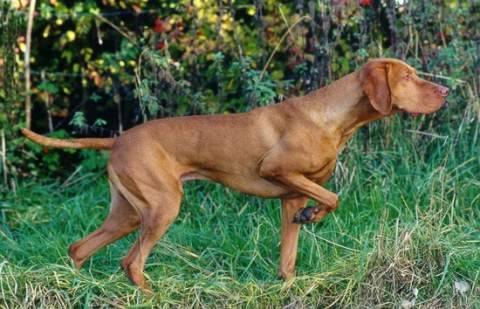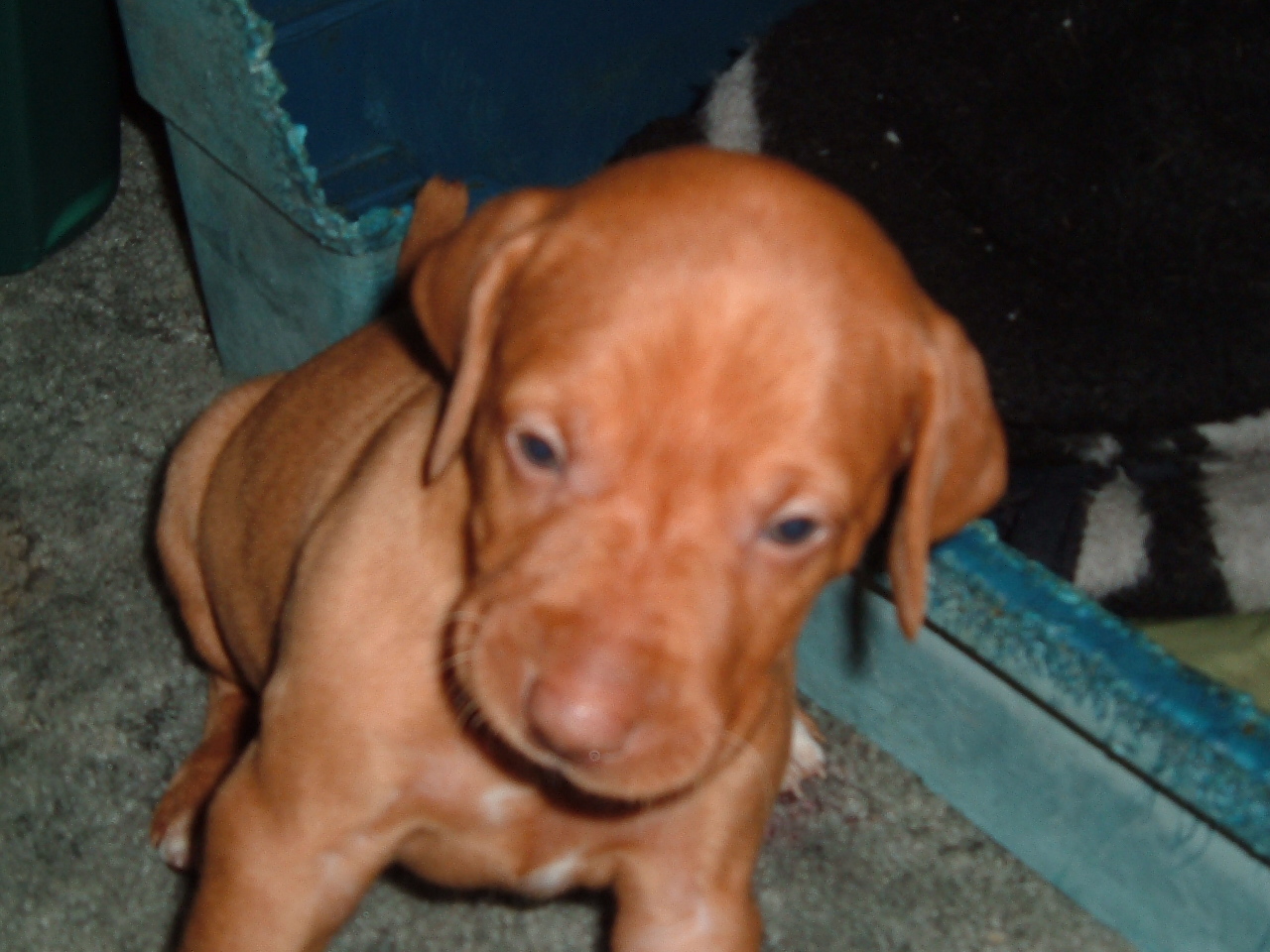|
Right Breed for You?
 |
 |
|
The Vizsla thrives as part of an active family that provides daily exercise. He is lively and affectionate
to his people, and possesses an above-average ability to take training. Although he sheds, his short coat requires low daily
maintenance.
- Sporting Group; AKC recognized in 1960.
- Average size: 21 to 24 inches tall at the shoulder.
- Hunting dog, family companion.
|
|
 |
 |
 |
 |
|
|
|
The life expectancy of the Vizsla is 12-15 years. The Vizsla is considered to be a robust dog, but some localized
breeding programs using a small number of dogs have led to heritable illnesses in some offspring, including:
Responsible breeders do not select dogs for breeding if they have such inherent problems.
|
|
 |
 |
|

|
|
Vizslas are very high energy, gentle-mannered, loyal, caring, and highly affectionate. They quickly form close bonds with
their owners, including children. Often they are referred to as "velcro" dogs because of their loyalty and affection. They
are quiet dogs, only barking if necessary or provoked.
They are natural hunters with an excellent ability to take training [2]. Not only are they great pointers, but they are excellent retrievers as well. They will retrieve on land and in the water, making the most of their natural instincts. However, they must be trained
gently and without harsh commands or strong physical correction, as they have sensitive temperaments and can be easily damaged
if trained too harshly.[8] Vizslas are excellent swimmers and often swim in pools if one is available. Like all gun dogs, Vizslas require a good deal of exercise to remain healthy and happy. Thirty minutes to an hour of exercise daily in a large
off-leash area is optimal.[9]
The Vizsla thrives on attention, exercise, and interaction. It is highly intelligent, and enjoys being challenged and stimulated,
both mentally and physically. Vizslas that do not get enough attention and exercise can easily become destructive or hyperactive.
Under-stimulated Vizslas may also become depressed or engage in obsessive-compulsive behaviours such as persistent licking.[9] Vizslas are very gentle dogs that are great around children. The Vizsla wants to be close to its owner as much of the
time as possible. Many Vizslas will sleep in bed with their owners if allowed, burrowing under the covers.
|
|
 |
|
Breed Standards
 |
 |
 General Appearance
That of a medium-sized short-coated hunting dog of distinguished appearance and
bearing. Robust but rather lightly built; the coat is an attractive solid golden rust. This is a dog of power and drive in
the field yet a tractable and affectionate companion in the home. It is strongly emphasized that field conditioned coats,
as well as brawny or sinewy muscular condition and honorable scars indicating a working and hunting dog are never to be penalized
in this dog. The qualities that make a "dual dog" are always to be appreciated, not deprecated.
Head
Lean and
muscular. Skull moderately wide between the ears with a median line down the forehead. Stop between skull and foreface
is moderate, not deep. Foreface or muzzle is of equal length or slightly shorter than skull when viewed in profile,
should taper gradually from stop to tip of nose. Muzzle square and deep. It must not turn up as in a "dish" face nor should
it turn down. Whiskers serve a functional purpose; their removal is permitted but not preferred. Nostrils slightly open. Nose
brown. Any other color is faulty. A totally black nose is a disqualification. Ears, thin, silky and proportionately
long, with rounded-leather ends, set fairly low and hanging close to cheeks. Jaws are strong with well developed white
teeth meeting in a scissors bite. Eyes medium in size and depth of setting, their surrounding tissue covering the whites.
Color of the iris should blend with the color of the coat. Yellow or any other color is faulty. Prominent pop-eyes are faulty.
Lower eyelids should neither turn in nor out since both conditions allow seeds and dust to irritate the eye. Lips cover
the jaws completely but are neither loose nor pendulous.
Neck and Body
Neck strong, smooth and muscular,
moderately long, arched and devoid of dewlap, broadening nicely into shoulders which are moderately laid back. This is mandatory
to maintain balance with the moderately angulated hindquarters. Body is strong and well proportioned. Back short. Withers
high and the topline slightly rounded over the loin to the set on of the tail. Chest moderately broad and deep
reaching down to the elbows. Ribs well-sprung; underline exhibiting a slight tuck-up beneath the loin. Tail set just
below the level of the croup, thicker at the root and docked one-third off. Ideally, it should reach to the back of the stifle
joint and be carried at or near the horizontal. An undocked tail is faulty.
Forequarters
Shoulder blades
proportionately long and wide sloping moderately back and fairly close at the top. Forelegs straight and muscular with
elbows close. Feet cat-like, round and compact with toes close. Nails brown and short. Pads thick and tough. Dewclaws, if
any, to be removed on front and rear feet. Hare feet are faulty.
Hindquarters
Hind legs have well developed
thighs with moderately angulated stifles and hocks in balance with the moderately laid back shoulders. They must be straight
as viewed from behind. Too much angulation at the hocks is as faulty as too little. The hocks are let down and parallel to
each other.
Coat
Short, smooth, dense and close-lying, without woolly undercoat. A distinctly long coat
is a disqualification.
Color
Solid golden rust in different shadings. Solid dark mahogany red and pale yellow
are faulty. White on the forechest, preferably as small as possible, and white on the toes are permissible. Solid white
extending above the toes or white anywhere else on the dog except the forechest is a disqualification. When viewing the
dog from the front, white markings on the forechest must be confined to an area from the top of the sternum to a point between
the elbows when the dog is standing naturally. White extending on the shoulders or neck is a disqualification. White
due to aging shall not be faulted. Any noticable area of black in the coat is a serious fault.
Gait
Far reaching,
light footed, graceful and smooth. When moving at a fast trot, a properly built dog single tracks.
Size
The ideal
male is 22 to 24 inches at the highest point over the shoulder blades. The ideal female is 21 to 23 inches. Because the Vizsla
is meant to be a medium-sized hunter, any dog measuring more than 1½ inches over or under these limits must be disqualified.
Temperament
A
natural hunter endowed with a good nose and above-average ability to take training. Lively, gentle-mannered, demonstrably
affectionate and sensitive though fearless with a well developed protective instinct. Shyness, timidity or nervousness should
be penalized.
|
| |
|
 |
 |

|
|





